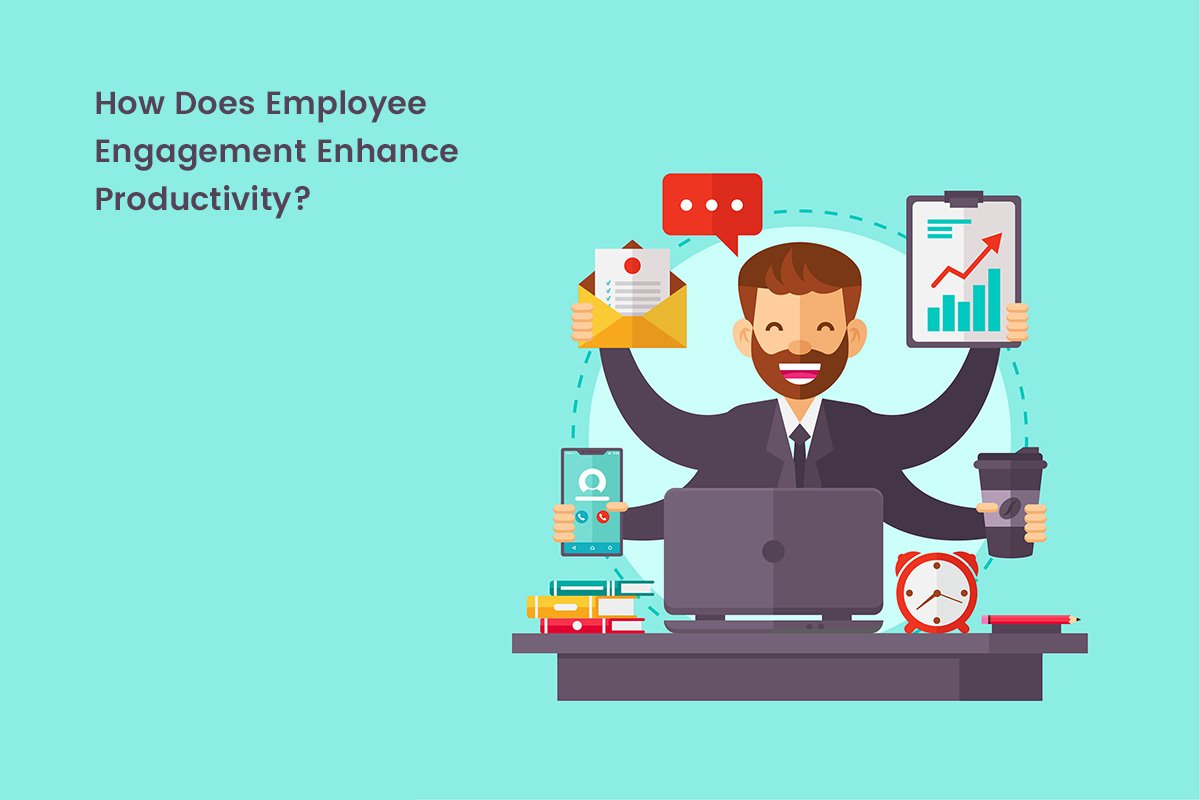What is Employee Engagement?
Employee engagement refers to the level of emotional commitment and involvement that employees have towards their work and the organization they work for. It goes beyond mere job satisfaction and measures the extent to which employees are motivated, enthusiastic, and invested in their roles and the overall success of the company.
Engaged employees are more likely to be passionate about their work, exhibit higher levels of productivity, and actively contribute to the organization’s goals and objectives. They feel a sense of purpose and connection to their work, which leads to greater job satisfaction, better job performance, and increased loyalty to the company.
Impact of Employee Engagement on Productivity
Employee engagement has a significant impact on productivity within organizations. When employees are engaged, they feel a strong sense of commitment, motivation, and connection to their work. This leads to several positive outcomes that directly contribute to increased productivity and overall performance.
Engaged employees tend to be more focused, proactive, and dedicated to their tasks. They have a higher level of job satisfaction and are driven to go above and beyond in their roles. Here are some key ways in which employee engagement positively influences productivity:
1. Increased Effort and Performance: Engaged employees are willing to put in extra effort and go the extra mile to achieve their goals. They take ownership of their work and strive for excellence, leading to improved performance and higher productivity levels.
2. Improved Time Management: Engaged employees are more likely to prioritize their tasks effectively and manage their time efficiently. They are focused on delivering results and are less prone to distractions, leading to better time utilization and productivity gains.
3. Enhanced Problem-Solving and Innovation: Engaged employees are actively involved in their work and take a proactive approach to problem-solving. They are more likely to think creatively, suggest innovative ideas, and contribute to process improvements, fostering a culture of continuous innovation and higher productivity.
4. Reduced Absenteeism and Turnover: Engaged employees have a higher level of commitment to their organization, which results in lower absenteeism rates and reduced turnover. When employees are engaged, they are more likely to be present and committed to their work, ensuring consistent productivity and continuity.
5. Positive Work Environment: Employee engagement contributes to a positive work environment where employees feel valued, supported, and motivated. A positive work culture promotes collaboration, teamwork, and effective communication, creating a conducive atmosphere for productivity to thrive.
Organizations that prioritize employee engagement understand the direct correlation between engagement and productivity. They invest in initiatives to foster engagement, such as providing growth opportunities, recognizing employee contributions, promoting work-life balance, and ensuring effective leadership. By creating an environment that nurtures engagement, organizations can unlock the full potential of their employees and achieve higher levels of productivity and success.
How Does Employee Engagement Increase Productivity?
Engaged employees are more likely to exhibit behaviors and attitudes that directly contribute to increased productivity. When employees are engaged, they go beyond the minimum requirements of their roles and are motivated to perform at their best. Here are some ways in which employee engagement increases productivity:
Being Present and Focused at Work:
Engaged employees are present both physically and mentally in their work. They are less likely to be distracted or disengaged during work hours, leading to increased focus and concentration on their tasks. By being fully present, they can dedicate their energy and attention to their work, resulting in higher productivity.
Going the Extra Mile:
Engaged employees have a sense of ownership and commitment to their work. They willingly put in extra effort, time, and energy to achieve their goals and deliver high-quality results. Whether it’s taking on additional responsibilities, working on projects outside their scope, or going above and beyond to meet deadlines, engaged employees are motivated to go the extra mile, leading to increased productivity.
Taking Pride in Their Work:
Engaged employees take pride in their work and strive for excellence. They have a personal investment in the outcomes of their efforts and are driven to produce high-quality outputs. This sense of pride and personal accountability motivates them to consistently perform at their best, resulting in increased productivity levels.
Being Innovative and Creative:
Engaged employees are more likely to think innovatively and creatively. They actively seek ways to improve processes, suggest new ideas, and find solutions to challenges. Their engagement fosters a culture of innovation within the organization, which leads to increased efficiency, problem-solving, and productivity gains.
Being Committed to Their Company’s Success:
Engaged employees have a strong sense of commitment and loyalty to their organization. They align their personal goals with the company’s objectives and are invested in its success. This commitment drives them to work towards achieving the organization’s goals, contributing to increased productivity and overall success.
Overall, employee engagement creates a positive work environment where employees are motivated, focused, and committed to their work and the organization’s success. Through their increased presence, effort, pride, innovation, and commitment, engaged employees directly contribute to higher productivity levels, leading to improved performance and outcomes for the organization as a whole.
How Are Employee Engagement And Productivity Related?
Employee engagement and productivity are closely intertwined and mutually reinforcing. When employees are engaged, it positively impacts their productivity levels, and increased productivity, in turn, enhances employee engagement. The relationship between employee engagement and productivity can be understood as follows:
Engagement Drives Productivity:
Employee engagement is a key driver of productivity within organizations. Engaged employees are emotionally and intellectually invested in their work, resulting in higher levels of motivation, commitment, and focus. They take personal ownership of their tasks, exhibit discretionary effort, and strive for excellence. Their engagement translates into increased productivity as they go the extra mile, perform at their best, and actively contribute to achieving organizational goals.
Productivity Enhances Engagement:
When employees experience a sense of accomplishment and see the impact of their efforts on outcomes, it reinforces their engagement. Increased productivity provides tangible evidence of their contributions and fosters a positive feedback loop. As employees see the results of their hard work, they feel a sense of pride, satisfaction, and fulfillment, further fueling their engagement and motivation to maintain and exceed productivity levels.
Positive Work Environment:
Employee engagement and productivity are influenced by a positive work environment. Organizations that prioritize employee engagement create a culture of trust, open communication, collaboration, and recognition. This positive environment supports and nurtures employee engagement, leading to increased productivity. When employees feel valued, supported, and respected, they are more likely to be engaged and motivated to perform at their best, resulting in higher productivity levels.
Continuous Improvement:
Engagement and productivity are not static but evolve over time. Engaged employees are more likely to seek opportunities for growth, development, and continuous improvement. As they enhance their skills, knowledge, and abilities, they become more effective and efficient in their work, leading to increased productivity. Likewise, the pursuit of productivity gains and achieving targets can also fuel employee engagement as employees feel a sense of accomplishment and pride in their ability to meet and exceed expectations.
Overall, employee engagement and productivity have a reciprocal relationship, with one influencing and reinforcing the other. Organizations that prioritize employee engagement are likely to experience higher productivity levels, while increased productivity contributes to sustained employee engagement. By focusing on both engagement and productivity, organizations can create a positive cycle that drives performance, success, and a thriving work culture.
Benefits Of Employee Engagement And Productivity
Employee engagement and productivity bring numerous benefits to both employees and organizations. When employees are engaged and productive, they contribute to a positive work environment and drive organizational success. Some key benefits include:
- Higher Employee Satisfaction: Engaged and productive employees tend to have higher job satisfaction levels. They feel fulfilled in their roles, experience a sense of purpose, and are more likely to stay committed to their organization.
- Improved Retention Rates: Organizations with high levels of employee engagement and productivity often experience lower turnover rates. Engaged employees are more likely to stay with the company, reducing recruitment and training costs.
- Enhanced Employee Well-being: Engaged employees often report better mental, emotional, and physical well-being. When employees are satisfied with their work and feel valued, it positively impacts their overall well-being.
- Increased Collaboration and Teamwork: Engaged and productive employees are more likely to collaborate effectively with their colleagues. They foster a positive work environment, encourage teamwork, and contribute to a supportive and cohesive team culture.
- Positive Customer Experiences: Engaged employees who are productive are more likely to deliver exceptional customer service. Their commitment to their work translates into better customer experiences, leading to increased customer satisfaction and loyalty.
- Higher Quality Outputs: Engaged and productive employees are driven to deliver high-quality outputs. They pay attention to detail, take pride in their work, and strive for excellence, resulting in improved product or service quality.
- Competitive Advantage: Organizations with a highly engaged and productive workforce gain a competitive edge. Engaged employees are more innovative, customer-focused, and adaptable, allowing organizations to respond effectively to market changes and outperform competitors.
How To Prevent Low Engagement?
Low employee engagement can have detrimental effects on productivity and overall organizational performance. To prevent low engagement and foster a positive work environment, consider the following strategies:
- Communicate Openly: Foster transparent and frequent communication to ensure employees are informed and engaged. Provide regular updates on organizational goals, changes, and successes.
- Provide Development Opportunities: Offer training, workshops, and career development programs to support employee growth and advancement. Providing avenues for skill-building and personal development enhances engagement.
- Recognize and Reward: Implement a recognition and rewards program to acknowledge employee efforts and achievements. Celebrate milestones and provide positive feedback to motivate and engage employees.
- Foster Work-Life Balance: Encourage work-life balance by promoting flexible work arrangements, encouraging breaks, and supporting employees’ personal well-being. Show that you value employees’ lives outside of work.
- Offer Meaningful Work: Ensure that employees understand the purpose and impact of their work. Connect their roles to the organization’s mission and demonstrate how their contributions make a difference.
- Provide Supportive Leadership: Invest in leadership development and train managers to be supportive, approachable, and effective communicators. Strong leadership plays a vital role in driving employee engagement.
- Solicit Employee Feedback: Regularly seek input from employees through surveys, focus groups, or suggestion boxes. Act on their feedback and involve employees in decision-making processes to foster engagement.
By implementing these strategies, organizations can prevent low engagement and create a work environment that promotes productivity, satisfaction, and success.
FAQs about Employee Productivity
Q1. What are the challenges of improving employee engagement?
Improving employee engagement can be challenging due to various factors. Some common challenges include lack of effective communication, limited resources, resistance to change, unclear expectations, and poor leadership. Overcoming these challenges requires a comprehensive approach that addresses these issues and fosters a culture of engagement.
Q2. What are some resources that can help me improve employee engagement?
Several resources are available to help organizations improve employee engagement. These include employee engagement software platforms, professional development and training programs, employee engagement surveys, HR consulting services, and industry publications. These resources provide guidance, tools, and best practices to support organizations in their efforts to enhance employee engagement.
Q3. What are some tips for improving employee engagement?
Improving employee engagement requires a multifaceted approach. Here are some tips to consider:
- Foster open and transparent communication channels.
- Provide opportunities for employee growth and development.
- Recognize and reward employee achievements.
- Promote work-life balance and employee well-being.
- Cultivate a positive work culture that values collaboration and teamwork.
- Involve employees in decision-making processes and solicit their feedback.
- Offer competitive compensation and benefits packages.
- Provide clear expectations and goals for employees.
- Invest in leadership development and training for managers.
Q4. Can employee engagement initiatives directly improve productivity?
Yes, employee engagement initiatives have a direct impact on productivity. Engaged employees are more motivated, focused, and committed to their work, leading to increased productivity levels. When employees feel valued, supported, and connected to their organization, they are more likely to go the extra mile, be proactive, and contribute to achieving organizational goals. Engaging employees through various initiatives, such as recognition programs, professional development opportunities, and fostering a positive work environment, can lead to improved productivity outcomes.
Bottom Line
In conclusion, employee engagement and productivity are closely linked, with each influencing and reinforcing the other. Engaged employees who are emotionally and intellectually invested in their work tend to be more productive and committed to achieving organizational goals. On the other hand, increased productivity contributes to employee satisfaction, a sense of accomplishment, and reinforces their engagement.
When employees are engaged, they are more likely to be present, focused, and go the extra mile in their work. They take pride in their work, are innovative and creative, and exhibit a commitment to their company’s success. This positive relationship between employee engagement and productivity brings a range of benefits, including higher employee satisfaction, improved retention rates, enhanced collaboration and teamwork, positive customer experiences, and a competitive advantage for organizations.
To prevent low engagement and foster a positive work environment, organizations can implement strategies such as open communication, providing development opportunities, recognizing and rewarding employee efforts, promoting work-life balance, offering meaningful work, supportive leadership, and soliciting employee feedback.
Employee productivity is influenced by various factors, including leadership, culture, work-life balance, compensation and benefits, opportunities for growth and development, recognition and rewards, and a sense of community within the organization. By understanding and addressing these factors, organizations can enhance employee engagement and productivity, leading to a more thriving and successful work environment.
Ultimately, investing in employee engagement and productivity is a win-win situation for both employees and organizations. Engaged employees are more likely to be productive and satisfied, contributing to overall organizational success and creating a positive and fulfilling work experience for everyone involved.
Are you looking for a meaningful and impactful way to engage your employees while making a positive difference in society? Consider partnering with Social For Action, a leading crowdfunding platform dedicated to corporate social responsibility (CSR) initiatives.
By signing up with Social For Action, your organization can leverage the power of crowdfunding to support employee engagement activities under your CSR policy.
Join Social For Action today and unlock the potential of employee engagement through CSR-driven crowdfunding. Together, we can make a difference in the lives of those in need while fostering a culture of giving and social responsibility within your organization.
Visit our website or contact us to learn more about how Social For Action can help you create meaningful employee engagement activities through crowdfunding. Let’s make a positive impact together!







Post a Comment